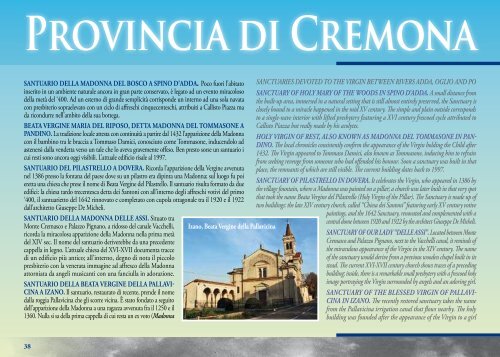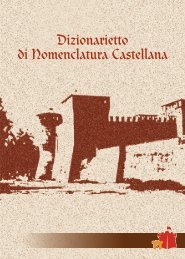luoghi e percorsi tra arte e fede nelle - Provincia di Cremona
luoghi e percorsi tra arte e fede nelle - Provincia di Cremona
luoghi e percorsi tra arte e fede nelle - Provincia di Cremona
You also want an ePaper? Increase the reach of your titles
YUMPU automatically turns print PDFs into web optimized ePapers that Google loves.
<strong>Provincia</strong> <strong>di</strong> <strong>Cremona</strong><br />
santuario della Madonna del Bosco a sPino d’adda. Poco fuori l’abitato<br />
inserito in un ambiente naturale ancora in gran p<strong>arte</strong> conservato, è legato ad un evento miracoloso<br />
della metà del ‘400. Ad un esterno <strong>di</strong> grande semplicità corrisponde un interno ad una sola navata<br />
con presbiterio sopraelevato con un ciclo <strong>di</strong> affreschi cinquecenteschi, attribuiti a Callisto Piazza ma<br />
da ricondurre nell’ambito della sua bottega.<br />
Beata verGine Maria del riPoso, detta Madonna del toMMasone a<br />
Pan<strong>di</strong>no. La <strong>tra</strong><strong>di</strong>zione locale attesta con continuità a partire dal 1432 l’apparizione della Madonna<br />
con il bambino <strong>tra</strong> le braccia a Tommaso Damici, conosciuto come Tommasone, inducendolo ad<br />
astenersi dalla vendetta verso un tale che lo aveva gravemente offeso. Ben presto sorse un santuario i<br />
cui resti sono ancora oggi visibili. L’attuale e<strong>di</strong>ficio risale al 1997.<br />
santuario del Pilastrello a dovera. Ricorda l’apparizione della Vergine avvenuta<br />
nel 1386 presso la fontana del paese dove su un pilastro era <strong>di</strong>pinta una Madonna; sul luogo fu poi<br />
eretta una chiesa che prese il nome <strong>di</strong> Beata Vergine del Pilastrello. Il santuario risulta formato da due<br />
e<strong>di</strong>fici: la chiesa tardo trecentesca detta dei Santoni con all’interno degli affreschi votivi del primo<br />
‘400, il santuarietto del 1642 rinnovato e completato con cupola ottagonale <strong>tra</strong> il 1920 e il 1922<br />
dall’architetto Giuseppe De Micheli.<br />
santuario della Madonna delle assi. Situato <strong>tra</strong><br />
Monte Cremasco e Palazzo Pignano, a ridosso del canale Vacchelli,<br />
ricorda la miracolosa apparizione della Madonna nella prima metà<br />
del XIV sec. Il nome del santuario deriverebbe da una precedente<br />
cappella in legno. L’attuale chiesa del XVI-XVII documenta <strong>tra</strong>cce<br />
<strong>di</strong> un e<strong>di</strong>ficio più antico; all’interno, degno <strong>di</strong> nota il piccolo<br />
presbiterio con la venerata immagine ad affresco della Madonna<br />
attorniata da angeli musicanti con una fanciulla in adorazione.<br />
santuario della Beata verGine della Pallavicina<br />
a izano. Il santuario, restaurato <strong>di</strong> recente, prende il nome<br />
dalla roggia Pallavicina che gli scorre vicina. È stato fondato a seguito<br />
dell’apparizione della Madonna a una ragazza avvenuta fra il 1250 e il<br />
1360. Nulla si sa della prima cappella <strong>di</strong> cui resta un ex voto (Madonna<br />
izano, Beata vergine della Pallavicina<br />
SANCTUARIES DEVOTED TO THE VIRGIN BETWEEN RIVERS ADDA, OGLIO AND PO<br />
sanCtuary of hoLy Mary of the wooDs in sPino D’aDDa. A small <strong>di</strong>stance from<br />
the built-up area, immersed in a natural setting that is still almost entirely preserved, the Sanctuary is<br />
closely bound to a miracle happened in the mid XV century. The simple and plain outside corresponds<br />
to a single-nave interior with lifted presbytery featuring a XVI century frescoed cycle attributed to<br />
Callisto Piazza but really made by his acolytes.<br />
hoLy virGin of rest, aLso Known as MaDonna DeL toMMasone in Pan-<br />
Dino. The local chronicles consistently confirm the appearance of the Virgin hol<strong>di</strong>ng the Child after<br />
1432. The Virgin appeared to Tommaso Damici, also known as Tommasone, inducing him to refrain<br />
from seeking revenge from someone who had offended his honour. Soon a sanctuary was built in that<br />
place, the remnants of which are still visible. The current buil<strong>di</strong>ng dates back to 1997.<br />
sanCtuary of PiLastreLLo in Dovera. It celebrates the Virgin, who appeared in 1386 by<br />
the village fountain, where a Madonna was painted on a pillar; a church was later built in that very spot<br />
that took the name Beata Vergine del Pilastrello (Holy Virgin of the Pillar). The Sanctuary is made up of<br />
two buil<strong>di</strong>ngs: the late XIV century church, called “Chiesa dei Santoni” featuring early XV century votive<br />
paintings, and the 1642 Sanctuary, renovated and complemented with a<br />
cen<strong>tra</strong>l dome between 1920 and 1922 by the architect Giuseppe De Micheli.<br />
sanCtuary of our LaDy “DeLLe assi”. Located between Monte<br />
Cremasco and Palazzo Pignano, next to the Vacchelli canal, it reminds of<br />
the miraculous appearance of the Virgin in the XIV century. The name<br />
of the sanctuary would derive from a previous wooden chapel built in its<br />
stead. The current XVI-XVII century church shows <strong>tra</strong>ces of a prece<strong>di</strong>ng<br />
buil<strong>di</strong>ng; inside, there is a remarkable small presbytery with a frescoed holy<br />
image por<strong>tra</strong>ying the Virgin surrounded by angels and an adoring girl.<br />
sanCtuary of the BLesseD virGin of PaLLavi-<br />
Cina in izano. The recently restored sanctuary takes the name<br />
from the Pallavicina irrigation canal that flows nearby. The holy<br />
buil<strong>di</strong>ng was founded after the appearance of the Virgin to a girl<br />
I SANTUARI MARIANI<br />
Marian Shrines<br />
con Bambino) del 1444, oggi incastonato nella quinta sinis<strong>tra</strong> del presbiterio. Il santuario rinascimentale<br />
venne costruito fra il 1542 e il 1570, a seguito del crollo della cappella precedente. La chiesa fu poi<br />
ingran<strong>di</strong>ta: nel XVII furono costruite le tre cappelle della parete nord. Attualmente il santuario funge<br />
da centro <strong>di</strong> preghiera per le vocazioni sacerdotali e religiose e ospita una comunità religiosa.<br />
santuario del Marzale a riPalta arPina. Il santuario sorge su un terrazzo naturale<br />
sul fiume Serio. Scavi archeologici hanno confermato la presenza <strong>di</strong> una necropoli tardoromana<br />
del III-IV secolo d.C. e <strong>di</strong> una longobarda altome<strong>di</strong>oevale. Il santuario venne fondato da Vinizone<br />
dell’XI secolo e qui si firmò la pace <strong>tra</strong> milanesi, lo<strong>di</strong>giani e cremaschi nel 1202. L’e<strong>di</strong>ficio sacro<br />
si presenta con un tetto a spiovente e un portico che lo circonda per due lati. Sotto il portico,<br />
una Via Crucis quasi cancellata <strong>di</strong> Tommaso Picenar<strong>di</strong> del 1757. All’interno, a capanna, vari<br />
affreschi del XIV-XVI secolo (Madonne del Latte). Ma la presenza <strong>di</strong> maggior pregio è quella<br />
<strong>di</strong> un gruppo ligneo della Pietà della seconda metà del Quattrocento, capolavoro <strong>di</strong> <strong>arte</strong> gotica<br />
popolare. Trafugato e poi ritrovato, ora è sostituito da una modesta copia (l’originale è in restauro).<br />
santuario della Madonna dei Prati a Moscazzano. Oasi <strong>di</strong> verde nel pressi <strong>di</strong><br />
Moscazzano, il santuario della Madonna dei prati, de<strong>di</strong>cato dal vescovo Oscar Cantoni alla preghiera<br />
per la famiglia. Ha una semplice facciata a capanna e uno slanciato campanile. Totalmente restaurato il<br />
santuario ingloba nell’abside una precedente e<strong>di</strong>cola del 1483. Al fianco nord s’appoggia un porticato<br />
e una casetta dove in passato <strong>di</strong>morava un eremita. Purtroppo l’immagine della Madonna <strong>di</strong> Eugenio<br />
Conti è stata recentemente <strong>tra</strong>fugata.<br />
santuario della Madonna del rosario <strong>di</strong> Monto<strong>di</strong>ne. Nei pressi del ponte<br />
sul Serio (sponda sinis<strong>tra</strong>) <strong>di</strong> Monto<strong>di</strong>ne sorge il santuario della Madonna del Rosario, piccolo gioiello<br />
del 1611-18. Molto belli gli affreschi <strong>di</strong> Gian Giacomo Barbelli (1604-56), maggior artista cremasco<br />
del Seicento, che ha <strong>di</strong>pinto volta e catino dell’abside con i Misteri del Rosario. Nella parete <strong>di</strong> fondo<br />
due fra i migliori affreschi del Barbelli: Santa Caterina da Siena e I santi Domenico e Francesco.<br />
santuario della Madonna del BinenGo a serGnano. Il santuario sorge sulle rive<br />
del Serio nei pressi <strong>di</strong> Sergnano su un alto terrapieno. Della località, <strong>di</strong> origine longobarda, si parla fin<br />
dal 1022. Non è nota la data della sua costruzione (certo prima del secolo XV), forse a seguito <strong>di</strong> una<br />
apparizione o del ritrovamento <strong>di</strong> una statua della Madonna nel fiume. La chiesetta, architettonicamente<br />
molto semplice e graziosa, preceduta da un pronao a tre archi, è arricchita da un ciclo <strong>di</strong> affreschi, <strong>di</strong> scuola<br />
some time between 1250 and 1360. Nothing is known about the prece<strong>di</strong>ng chapel, whose existence is<br />
testified to by an ex-voto (holy virgin with Child) dating back to 1444, and currently preserved in<br />
the left wing of the presbytery. The Renaissance sanctuary was built between 1542 and 1570, after<br />
the collapse of the previous chapel. The church was later expanded: three chapels were annexed to the<br />
north wall in the XVII century. Currently the buil<strong>di</strong>ng is a place for prayer for ministry and religious<br />
calling and houses a religious community.<br />
sanCtuary of MarziaLe in riPaLta arPina. The Sanctuary lies on a natural rise by<br />
river Serio. Archaeological excavations confirmed the presence of a late-Roman necropolis dating<br />
back to the III-IV century AD and an early-middle-ages Lombard burial ground. The Sanctuary was<br />
founded by Vinizone in the XI century; here a peace treaty was signed between the armies of Milan,<br />
Lo<strong>di</strong> and Crema in 1202. The sacred buil<strong>di</strong>ng has pitched roofing and an arcade surroun<strong>di</strong>ng it on<br />
two sides. Under the arcade, there is an almost vanished 1757 via Crucis by Tommaso Picenar<strong>di</strong>.<br />
The pitch-ceilinged inside features several frescoes from the XIV-XVI century (our Lady of Milk).<br />
The most remarkable feature, though, is a wooden sculpture por<strong>tra</strong>ying a Pietà dating back to the mid<br />
XV century, a masterpiece of popular gothic art. Stolen and then found, now it is replaced by a fairly<br />
good copy (the original is being restored).<br />
sanCtuary of our LaDy of the MeaDows in MosCazzano. A green haven<br />
by Moscazzano, the Sanctuary of Our Lady of the Meadows was commissioned by the bishop Oscar<br />
Cantoni to give his family a place to pray. It features a simple pitched façade and a very tall bell tower.<br />
The sanctuary was extensively restored and in the apse it includes a 1483 ae<strong>di</strong>cule. On the north side<br />
there is an arcade and a little hut where a hermit used to dwell. Sadly, the Madonna by Eugenio<br />
Conti was recently stolen.<br />
sanCtuary of our LaDy of the rosary in MontoDine. By the bridge over river Serio<br />
(laft bank) at Monto<strong>di</strong>ne there is the Sanctuary of Our Lady of the Rosary, a jewel dating back 1611-18.<br />
It features beautiful frescoes by Gian Giacomo Barbelli (1604-56), the major XVI artist in the Crema<br />
area, who painted the vault and half-dome of the apse with the Mysteries of the rosary. The bottom wall<br />
features two of the best frescoes by Barbelli: saint Catherine of siena and saint Dominic and francis.<br />
sanCtuary of our LaDy of BinenGo in serGnano. The Sanctuary lies on the<br />
bank of river Serio by Sergnano, on a high artificial rise. The place, of Lombard origin, appears in the<br />
38 39



